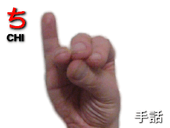Chi (kana)
ち, in hiragana, or チ in katakana, is one of the Japanese kana, which each represent one mora. Both are phonemically /ti/ although for phonological reasons, the actual pronunciation is [t͡ɕi] (![]()
| chi | ||||
|---|---|---|---|---|
| ||||
| transliteration | chi, ti | |||
| translit. with dakuten | ji, zi, di | |||
| hiragana origin | 知 | |||
| katakana origin | 千 | |||
| spelling kana | 千鳥のチ (Chidori no "chi") | |||
| kana gojūon | ||||||||||||||||||||||||||||||||||||||||||||||||||
|---|---|---|---|---|---|---|---|---|---|---|---|---|---|---|---|---|---|---|---|---|---|---|---|---|---|---|---|---|---|---|---|---|---|---|---|---|---|---|---|---|---|---|---|---|---|---|---|---|---|---|
|
||||||||||||||||||||||||||||||||||||||||||||||||||
The kanji for one thousand (千, sen), appears similar to チ, and at one time they were related, but today チ is used as phonetic, while the kanji carries an entirely unrelated meaning.
Many onomatopoeic words beginning with ち pertain to things that are small or quick.[1]
The dakuten forms ぢ, ヂ, pronounced the same as the dakuten forms of the shi kana in most dialects (see yotsugana), are uncommon. They are primarily used for indicating a voiced consonant in the middle of a compound word (see rendaku), and they can never begin a word, although some people will write the word for hemorrhoids (normally じ) as ぢ for emphasis. The dakuten form of the shi character is sometimes used when transliterating "di", as opposed to チ's dakuten form; for example, Aladdin is written as アラジン Arajin, and radio is written as ラジオ. More common, though, is to use ディ instead, such as ディオン to translate the name Dion.
In the Ainu language, チ by itself is pronounced [t͡ʃi], and can be combined with the katakana ヤ, ユ, エ, and ヨ to write the other [t͡ʃ] sounds as well as [t͡s] sounds. The combination チェ (pronounced [t͡se]), is interchangeable with セ゚.
Form variants
| Form | Rōmaji | Hiragana | Katakana | ||
|---|---|---|---|---|---|
| Hepburn | Kunrei-shiki | Nihon-shiki | |||
| Normal ch-/t- (た行 ta-gyō) |
chi | ti | ち | チ | |
| chii chī |
tii tī |
ちい, ちぃ ちー |
チイ, チィ チー | ||
| Addition yōon ch-/ty- (ちゃ行 cha-gyō) |
cha | tya | ちゃ | チャ | |
| chaa chā |
tyaa tyā |
ちゃあ ちゃー |
チャア チャー | ||
| chu | tyu | ちゅ | チュ | ||
| chuu chū |
tyuu tyū |
ちゅう ちゅー |
チュウ チュー | ||
| cho | tyo | ちょ | チョ | ||
| chou choo chō |
tyou tyoo tyō |
ちょう ちょお ちょー |
チョウ チョオ チョー | ||
| Addition dakuten d- (j/z-) (だ行 da-gyō) |
ji | zi | di | ぢ | ヂ |
| jii jī |
zii zī |
dii dī |
ぢい, ぢぃ ぢー |
ヂイ, ヂィ ヂー | |
| Addition yōon and dakuten dy- (j/zy-) (ぢゃ行 dya-gyō) |
ja | zya | dya | ぢゃ | ヂャ |
| jaa jā |
zyaa zyā |
dyaa dyā |
ぢゃあ ぢゃー |
ヂャア ヂャー | |
| ju | zyu | dyu | ぢゅ | ヂュ | |
| juu jū |
zyuu zyū |
dyuu dyū |
ぢゅう ぢゅー |
ヂュウ ヂュー | |
| jo | zyo | dyo | ぢょ | ヂョ | |
| jou joo jō |
zyou zyoo zyō |
dyou dyoo dyō |
ぢょう ぢょお ぢょー |
ヂョウ ヂョオ ヂョー | |
| Other additional forms | |||||||||||||||||||||||||||||||||||||
|---|---|---|---|---|---|---|---|---|---|---|---|---|---|---|---|---|---|---|---|---|---|---|---|---|---|---|---|---|---|---|---|---|---|---|---|---|---|
|
| ||||||||||||||||||||||||||||||||||||
Stroke order
 Stroke order in writing ち |
 Stroke order in writing チ |


Other communicative representations
| Japanese radiotelephony alphabet | Wabun code |
| 千鳥のチ Chidori no "Chi" |
 |
|
 |
 |
| Japanese Navy Signal Flag | Japanese semaphore | Japanese manual syllabary (fingerspelling) | Braille dots-1235 Japanese Braille |
- Full Braille representation
| ち / チ in Japanese Braille | Ch/J/Dy + Yōon braille | ||||||
|---|---|---|---|---|---|---|---|
| ち / チ chi | ぢ / ヂ ji/di | ちい / チー chī | ぢい / ヂー jī/dī | ちゃ / チャ cha | ぢゃ / ヂャ ja/dya | ちゃあ / チャー chā | ぢゃあ / ヂャー jā/dya |
| Ch/J/Dy + Yōon braille | |||||||
| ちゅ / チュ chu | ぢゅ / ヂュ ju/dyu | ちゅう / チュー chū | ぢゅう / ヂュー jū/dyū | ちょ / チョ cho | ぢょ / ヂョ jo/dyo | ちょう / チョー chō | ぢょう / ヂョー jō/dyō |
| Preview | ち | チ | チ | ぢ | ヂ | |||||
|---|---|---|---|---|---|---|---|---|---|---|
| Unicode name | HIRAGANA LETTER TI | KATAKANA LETTER TI | HALFWIDTH KATAKANA LETTER TI | HIRAGANA LETTER DI | KATAKANA LETTER DI | |||||
| Encodings | decimal | hex | decimal | hex | decimal | hex | decimal | hex | decimal | hex |
| Unicode | 12385 | U+3061 | 12481 | U+30C1 | 65409 | U+FF81 | 12386 | U+3062 | 12482 | U+30C2 |
| UTF-8 | 227 129 161 | E3 81 A1 | 227 131 129 | E3 83 81 | 239 190 129 | EF BE 81 | 227 129 162 | E3 81 A2 | 227 131 130 | E3 83 82 |
| Numeric character reference | ち | ち | チ | チ | チ | チ | ぢ | ぢ | ヂ | ヂ |
| Shift JIS[2] | 130 191 | 82 BF | 131 96 | 83 60 | 193 | C1 | 130 192 | 82 C0 | 131 97 | 83 61 |
| EUC-JP[3] | 164 193 | A4 C1 | 165 193 | A5 C1 | 142 193 | 8E C1 | 164 194 | A4 C2 | 165 194 | A5 C2 |
| GB 18030[4] | 164 193 | A4 C1 | 165 193 | A5 C1 | 132 49 152 57 | 84 31 98 39 | 164 194 | A4 C2 | 165 194 | A5 C2 |
| EUC-KR[5] / UHC[6] | 170 193 | AA C1 | 171 193 | AB C1 | 170 194 | AA C2 | 171 194 | AB C2 | ||
| Big5 (non-ETEN kana)[7] | 198 197 | C6 C5 | 199 89 | C7 59 | 198 198 | C6 C6 | 199 90 | C7 5A | ||
| Big5 (ETEN / HKSCS)[8] | 199 72 | C7 48 | 199 189 | C7 BD | 199 73 | C7 49 | 199 190 | C7 BE | ||
| Preview | ㋠ | |
|---|---|---|
| Unicode name | CIRCLED KATAKANA TI | |
| Encodings | decimal | hex |
| Unicode | 13024 | U+32E0 |
| UTF-8 | 227 139 160 | E3 8B A0 |
| Numeric character reference | ㋠ | ㋠ |
References
| Look up ち, ぢ, チ, or ヂ in Wiktionary, the free dictionary. |
- Hiroko Fukuda, Jazz Up Your Japanese with Onomatopoeia: For All Levels, trans. Tom Gally. New York: Kodansha International (2003): 19 - 20, Introduction, Words Beginning with ち Chi, Indicating Smallness or Quickness.
- Unicode Consortium (2015-12-02) [1994-03-08]. "Shift-JIS to Unicode".
- Unicode Consortium; IBM. "EUC-JP-2007". International Components for Unicode.
- Standardization Administration of China (SAC) (2005-11-18). GB 18030-2005: Information Technology—Chinese coded character set.
- Unicode Consortium; IBM. "IBM-970". International Components for Unicode.
- Steele, Shawn (2000). "cp949 to Unicode table". Microsoft / Unicode Consortium.
- Unicode Consortium (2015-12-02) [1994-02-11]. "BIG5 to Unicode table (complete)".
- van Kesteren, Anne. "big5". Encoding Standard. WHATWG.

